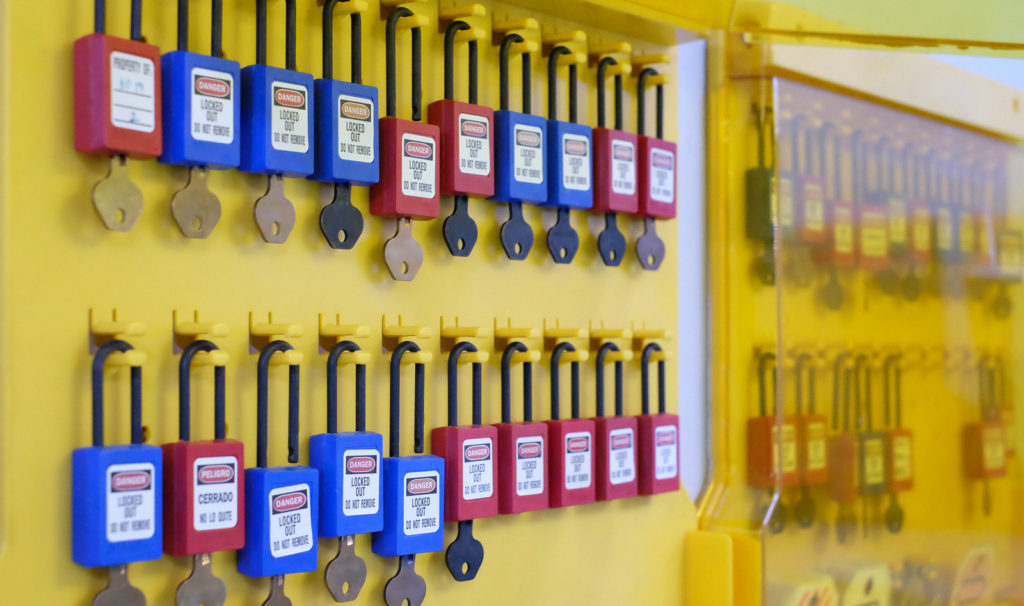Between October 2018 and September 2019, OSHA issued a total of $7,171,513 in fines to the food manufacturing industry. This is the result of 1,168 citations (down from 1,584 last year), as the industry continues to strive for safer workplace conditions.
Here are the most frequently cited standards in food manufacturing for 2019:
1. The control of hazardous energy (lockout/tagout)
Citations: 246
Penalties: $2,577,567
Standard 1910.147 covers the servicing and maintenance of machines and equipment in which the unexpected energization or start up of the machines or equipment, or release of stored energy, could harm employees.
Lockout/tagout tops this list again this year. The CDC points the finger at the fast pace with which employees are required to work. When machines go down, the primary goal is to get them back up and running as soon as possible. Unfortunately, this often means maintenance workers don’t take proper steps to de-energize the equipment first.
With the increase in computer-based controls, OSHA is requesting information on the strengths, limitations, and possible hazards associated with this new technology. This could lead to future standard updates.
2. General requirements for all machines
Citations: 153
Penalties: $1,364,230
Standard 1910.212 requires proper machine guarding to protect the operator and other employees in the machine area from hazards such as those created by point of operation, ingoing nip points, rotating parts, flying chips, and sparks.
Despite the challenge of designing guards with hygienic qualities, OSHA stresses that all machinery and power transmission apparatus in food processing facilities must be guarded.
3. Mechanical power-transmission apparatus
Citations: 65
Penalties: $228,602
Standard 1910.219 covers most types and shapes of power-transmission belts, pulleys, gears, and more and sets the requirements for guarding such equipment.
4. Hazard communication
Citations: 63
Penalties: $84,685
Standard 1910.1200 requires the classification of all hazardous chemicals, produced or imported, as well as informing workers about any hazardous materials to which they are exposed. This includes materials like combustible dust, a common danger in the food industry.
OSHA is still in discussions regarding updates to the hazard communication standard to reflect the latest revisions to the Globally Harmonized System (GHS).
5. Powered industrial trucks
Citations: 49
Penalties: $131,052
Standard 1910.178 covers fire protection, design, and maintenance for powered industrial trucks. In food manufacturing, this most often applies to forklifts.
This standard is on OSHA’s agenda for potential updates. Encouraged by the Industrial Truck Association, the agency will be considering updates that reflect revisions to ANSI standards on powered industrial trucks over the last 45 years.
6. General requirements – electrical
Citations: 47
Penalties: $141,801
Standard 1910.303 covers the examination, installation, and use of electrical equipment. It includes requirements like floor markings to indicate electrical hazards and providing sufficient access and working space around electrical equipment.
7. Wiring methods, components, and equipment for general use
Citations: 45
Penalties: $88,684
Standard 1910.305 specifies the requirements for permanent and temporary wiring installations and components like raceways, frames, and fittings. One provision protects against fires and explosions by prohibiting wiring from being installed in any ducts used to transport dust.
8. Process safety management of highly hazardous chemicals
Citations: 33
Penalties: $731,401
Standard 1910.119 includes requirements for preventing or minimizing the consequences of catastrophic releases of toxic, reactive, flammable, or explosive chemicals.
From anhydrous ammonia used in cooling systems to disinfectants used to clean equipment, there are many hazardous chemicals found in food plants. Workers who may come into contact with these chemicals must be informed, use proper work practices, and wear appropriate personal protective equipment (PPE).
9. Safety requirements for scaffolding
Citations: 30
Penalties: $319,256
Standard 1910.28 requires protection for each employee against falls and falling object hazards.
10. General requirements – personal protective equipment
Citations: 30
Penalties: $103,635
Standard 1910.132 requires the provision, maintenance, sanitation, and use of personal protective equipment (PPE) to protect against chemical hazards, radiological hazards, or mechanical irritants.
